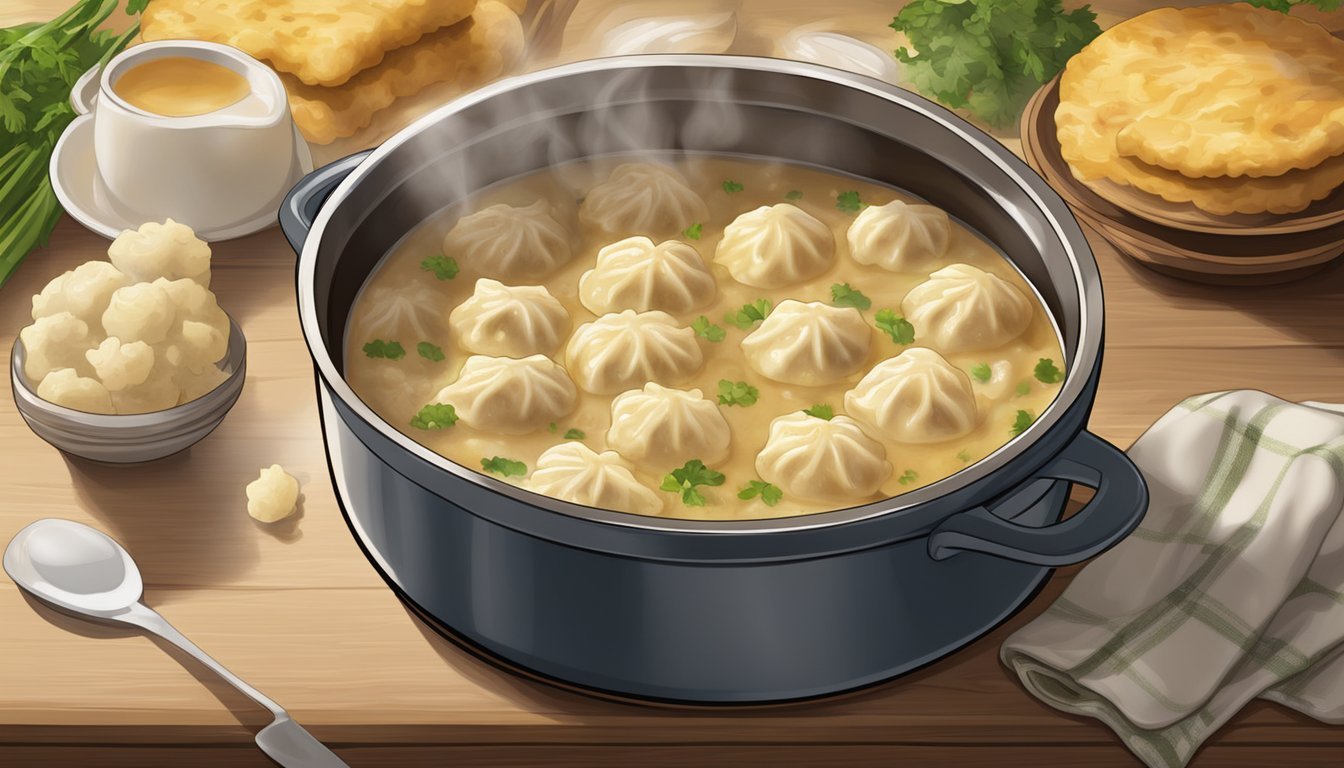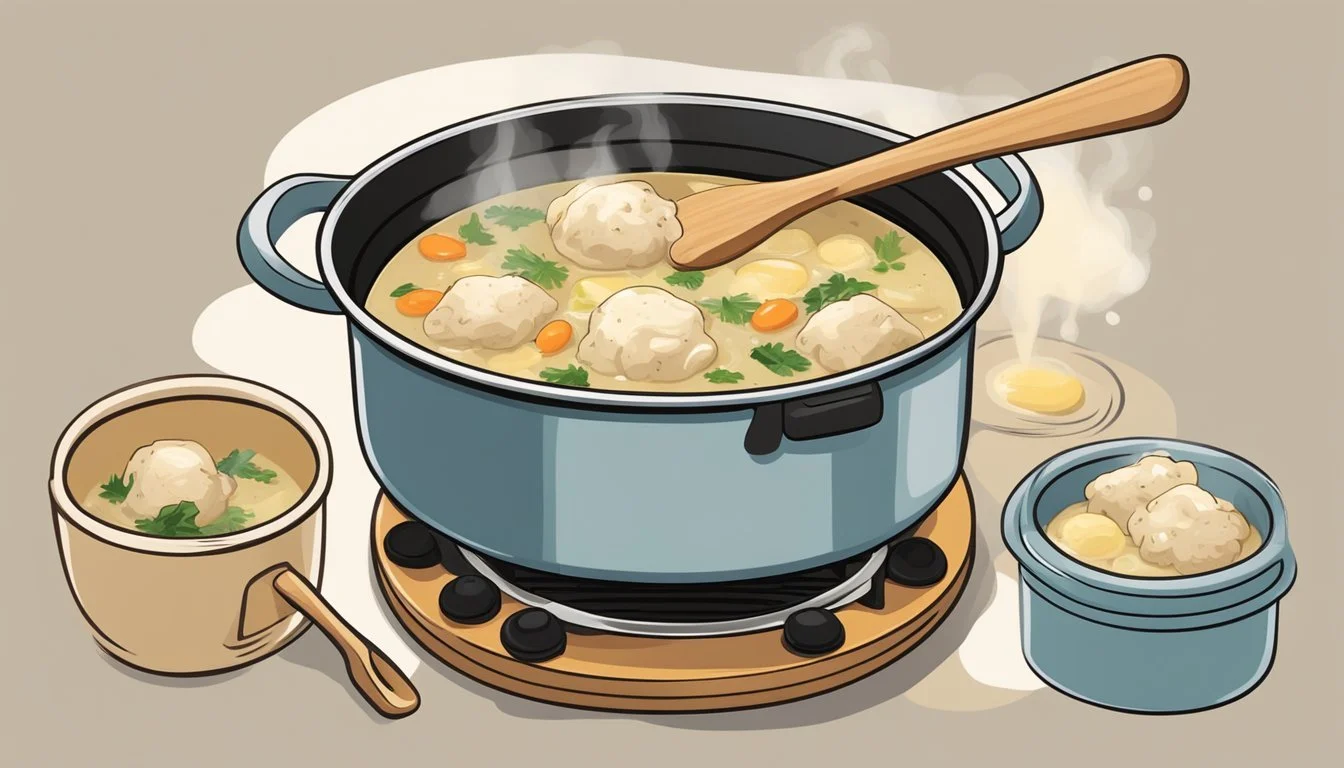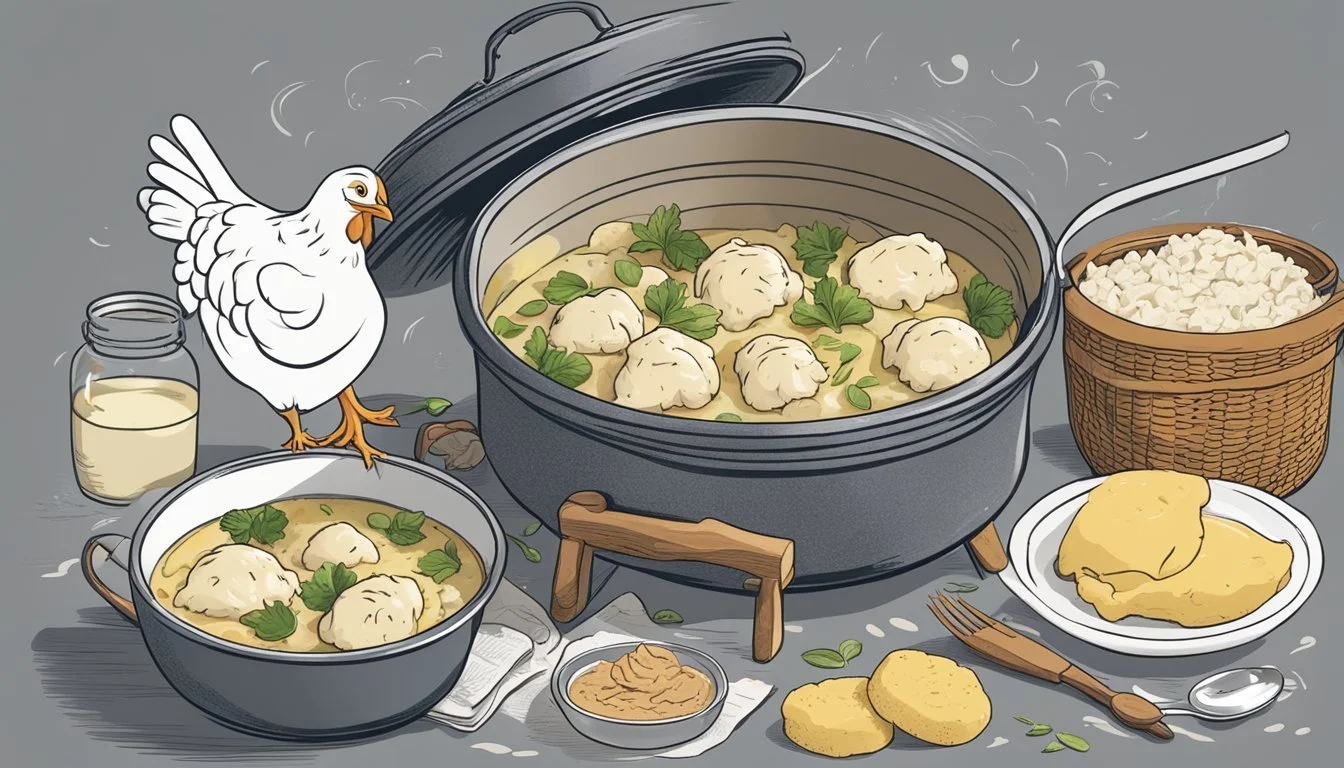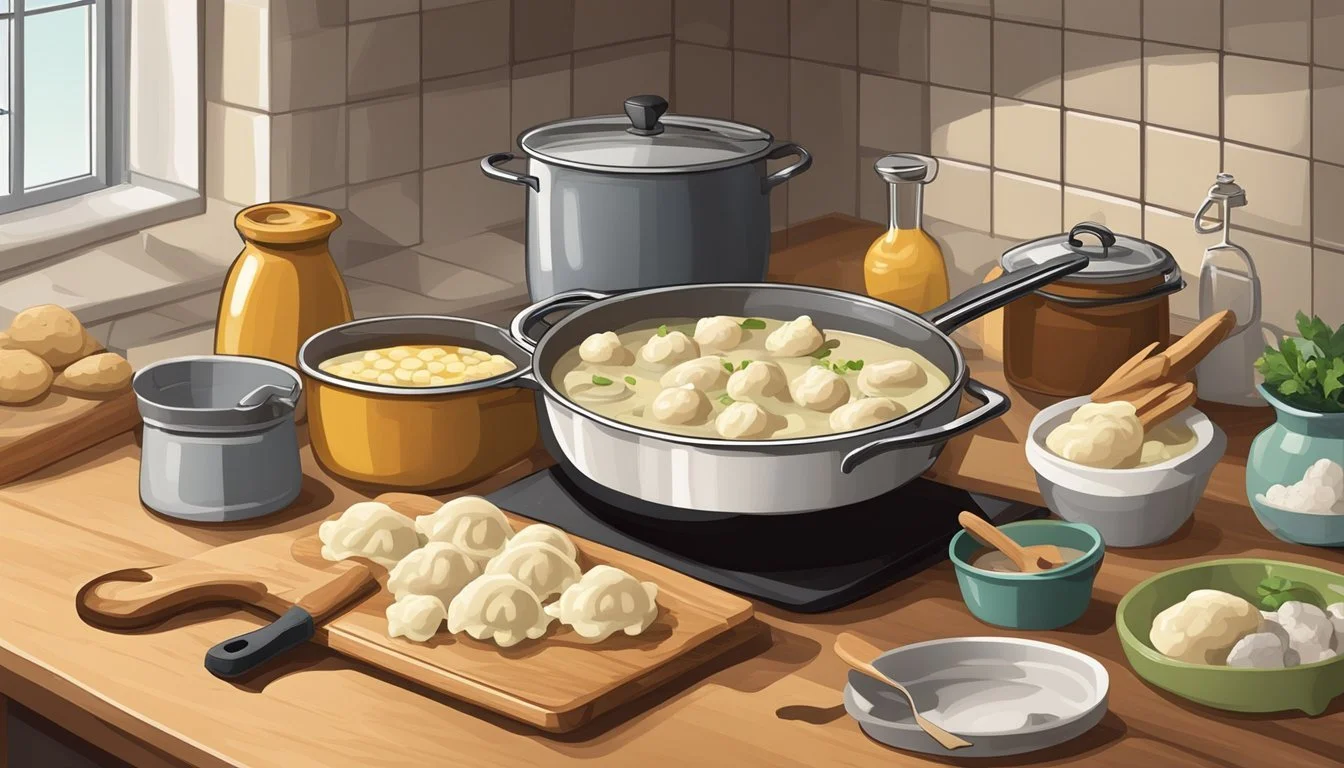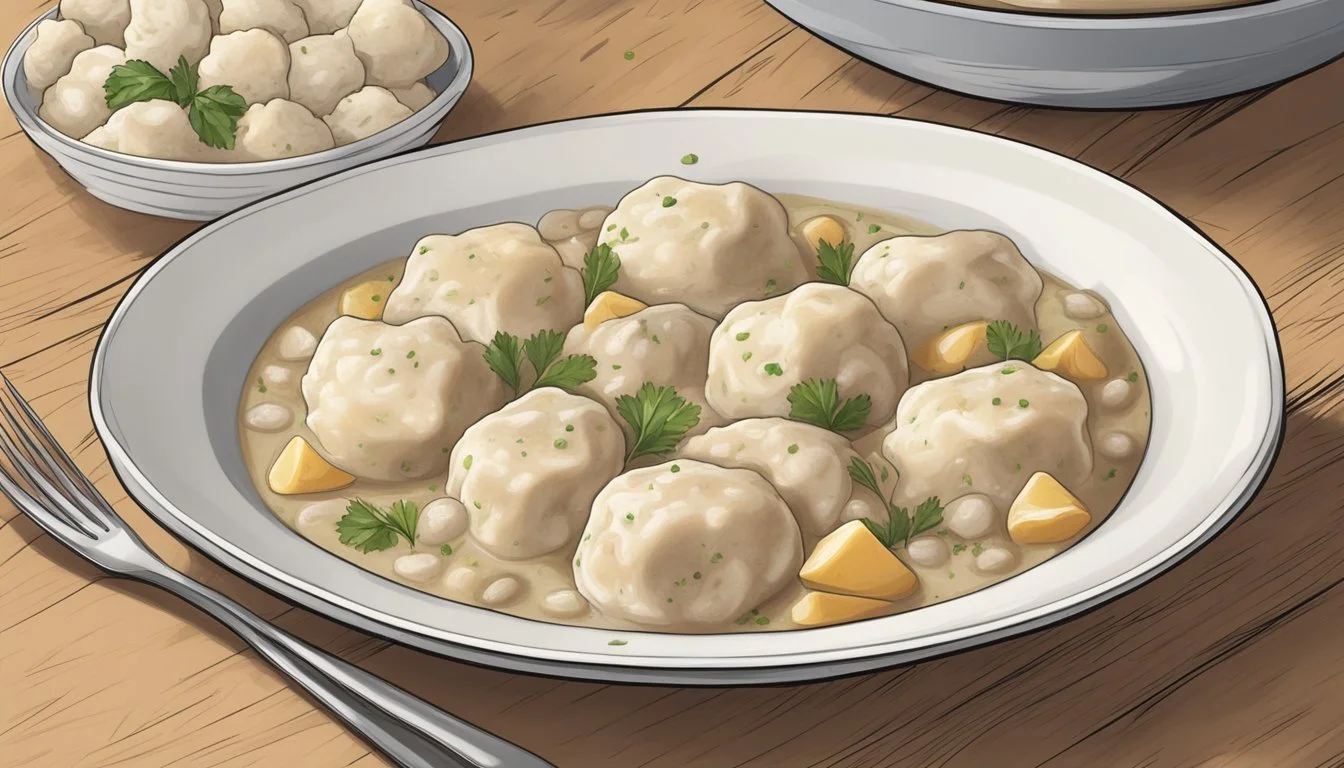Is Chicken and Dumplings Gluten-Free?
Unveiling the Facts About This Classic Dish
Chicken and dumplings is a comforting classic in American cuisine, traditionally consisting of a chicken stew with doughy dumplings. This dish's warmth and heartiness are matched by its versatility, as it lends itself well to gluten-free adaptations. Individuals with gluten sensitivities or celiac disease often find that many traditional recipes are off-limits due to the presence of gluten-containing ingredients. However, with the increasing availability of gluten-free flours and other substitutes, it is possible to enjoy a gluten-free version of chicken and dumplings without compromising on taste or texture.
The key to gluten-free chicken and dumplings lies in the preparation of the dumplings themselves. Regular dumplings are typically made with wheat flour, which contains gluten. By substituting with gluten-free flour blends, which may incorporate rice flour, almond flour, or other gluten-free alternatives, along with a binding agent such as xanthan gum, the dumplings can be rendered safe for those avoiding gluten. It's essential to ensure that all components, including the chicken broth and any added seasonings, are free from gluten to avoid cross-contamination.
Taking into consideration the substitutions and precautions necessary for a gluten-free diet, the dish can be both safe and satisfying. Whether using a homemade chicken broth or a store-bought variety, one must always check the labels for hidden sources of gluten. With careful selection of ingredients and slight modifications to the traditional recipe, chicken and dumplings can be transformed into a delightful gluten-free meal that is as nourishing as it is flavorful, allowing those on a gluten-restricted diet to enjoy this homestyle favorite.
Understanding Gluten in Traditional Chicken and Dumplings
The traditional chicken and dumplings dish is often not gluten-free due to specific ingredients used in its preparation. This section explores the specific components that contain gluten and their alternatives for a gluten-free diet.
Components of Classic Chicken and Dumplings
The classic chicken and dumplings dish typically comprises a hearty chicken stew with a mixture of vegetables and soft dumplings. The stew is usually made from chicken, broth, and various vegetables, while the dumplings are formed from flour, baking powder, salt, and milk or water.
Sources of Gluten in Dumplings
Gluten is a protein found in wheat, barley, and rye. In dumplings, the primary source of gluten is the flour made from these grains. Baking powder, which is used to make dumplings rise and become fluffy, is gluten-free, but it is often combined with gluten-containing flour.
The Role of Gluten in Texture
Gluten provides elasticity and strength to dough, which is why traditional dumplings have a characteristic fluffy and chewy texture. When the flour is mixed with moisture and heat is applied, gluten proteins form a sticky network that traps air, creating the pillow-like feel of classic dumplings.
Impact of Gluten on Health
For individuals with celiac disease or gluten sensitivity, ingesting gluten can lead to various health issues, such as digestive discomfort, nutrient malabsorption, and intestinal damage. Consuming gluten can trigger an immune response that is detrimental to their health.
Benefits of a Gluten-Free Diet
A gluten-free diet can offer considerable health benefits for those with celiac disease or a sensitivity to gluten. It can alleviate symptoms related to gluten ingestion and promote intestinal healing. Additionally, for individuals without gluten-related disorders, a gluten-free diet can still be nutritionally adequate if well-planned.
Ingredients for Gluten-Free Chicken and Dumplings
Creating gluten-free chicken and dumplings requires careful selection of suitable substitutes to traditional ingredients that contain gluten. By focusing on gluten-free alternatives for flour, broth, and other core ingredients, one can enjoy this classic dish without compromising on taste or texture.
Choosing the Right Gluten-Free Flour
The foundation of gluten-free dumplings is a reliable gluten-free flour blend. A recommended option is Bob's Red Mill Gluten-Free 1-to-1 Baking Flour which often includes a mix of rice flour, potato starch, and other gluten-free flours. It's important to check that the blend contains xanthan gum, an additive that mimics the binding properties of gluten.
Alternatives to Traditional Ingredients
In gluten-free cooking, replacing dairy components can be just as important as avoiding wheat-based products. Instead of regular milk and butter, one can opt for dairy-free milk like almond milk or soy milk, and dairy-free butter or even oils for sautéing vegetables. These alternatives should be chosen based on their neutral flavor and ability to blend well with other ingredients.
Selecting Gluten-Free Broth and Stock
For the soup base, it's essential to use a gluten-free chicken broth or stock. Labels should be read carefully to avoid broths with added wheat-based fillers or flavorings. Organic or homemade broths offer a safer alternative and enrich the dish with a robust chicken flavor.
Protein and Vegetable Components
Central to the dish is chicken, where any form such as cooked chicken, rotisserie chicken, chicken thighs (What wine goes well with chicken thighs?), or chicken breast can serve as the protein. When combined with a mix of classic vegetables like onions, carrots, and celery, these ingredients provide the hearty and satisfying profile expected from chicken and dumplings. All vegetables and proteins should be fresh or properly prepared to ensure the best flavor.
Step-by-Step Gluten-Free Recipe Guide
Crafting gluten-free chicken and dumplings involves a meticulous process where precise ingredients create a flavorful stew and soft, doughy dumplings without the use of traditional wheat flour.
Preparing the Chicken and Broth
To begin, heat olive oil in a large pot or Dutch oven over medium-high heat. Season chicken pieces with kosher salt and ground black pepper, then sear until golden brown on both sides. For a richer soup, use a whole chicken—it provides more flavor and body to the broth. Once seared, remove the chicken and set aside. In the same pot, add chopped onions, carrots, and celery; cook until softened. Pour in chicken broth and add bay leaves; return the chicken to the pot. Bring to a simmer until the chicken is cooked thoroughly.
Making the Gluten-Free Dumplings
In a separate bowl, combine gluten-free flour (ensure it includes xanthan gum if not pre-blended), baking powder, and a pinch of salt; mix these dry ingredients. In a small dish, beat an egg and mix it with milk. Gradually combine the wet ingredients into the flour mixture, stirring to form the dumpling dough—it should hold together but remain slightly sticky.
Combining Ingredients and Cooking
Once the chicken is fully cooked, remove it from the pot and debone if necessary. Shred or chop into bite-sized pieces, then return it to the pot. Scoop spoonfuls of dumpling dough and drop them into the simmering broth. Cover the pot and let the soup cook over low heat. The dumplings will expand and float to the top as they cook.
Final Touches and Seasoning Adjustments
As the dish nears completion, finely chop fresh parsley and add it to the pot for a fresh flavor dimension. Taste the stew and adjust the seasoning with more salt, black pepper, and other preferred spices like thyme. The broth may be thickened with a starch slurry if a richer consistency is desired. Serve hot once the dumplings are cooked through and have a tender, fluffy texture.
Serving and Presentation
When it comes to serving gluten-free chicken and dumplings, the focus is on maintaining the comfort food appeal while underscoring the gluten-free aspect of the dish. It's not just about the taste; presentation is key to making this family favorite shine at the dining table.
Portioning and Plating Tips
For optimal portioning, one should allocate about 1 to 1 1/2 cups of chicken and dumplings per serving. When plating, they should ensure that each dish features a generous helping of dumplings atop the chicken and vegetable stew to balance each of the dish's components. Using pre-heated bowls can help keep the dish warm and enhance the dining experience.
Garnishing for Added Appeal
A light sprinkle of finely chopped parsley or chives can add a pop of color and freshness to gluten-free chicken and dumplings. A modest grind of black pepper atop the dish can also heighten its visual appeal and flavor profile without overwhelming the other ingredients.
Recommended Side Dishes
While gluten-free chicken and dumplings is hearty enough to stand as a main course, it can be paired with simple side dishes to create a fuller meal. Options include:
Steamed vegetables: A selection of steamed vegetables such as broccoli or green beans, lightly seasoned with salt and pepper.
Salad: A crisp green salad with a vinaigrette dressing can provide a refreshing counterpoint to the dish.
Gluten-free bread: A slice of warm, gluten-free bread can complement the creaminess of the dumplings and absorb the savory stew.
Striving for a balance of flavors and textures in the accompaniments will elevate the overall dining experience.
Dietary Considerations and Substitutions
Making chicken and dumplings gluten-free requires careful ingredient selection and preparation to ensure that the meal complies with dietary needs while still being enjoyable and flavorful.
Vegetarian and Vegan Variations
To adapt chicken and dumplings for vegetarians, one can substitute the chicken with plant-based protein sources like tofu or seitan. (What wine goes well with seitan?) For a vegan version, it's also essential to replace traditional dairy ingredients with alternatives such as almond or coconut milk. Adding a variety of vegetables like mushrooms can enhance flavor and nutrition.
Allergen-Conscious Alternatives
Gluten-free chicken and dumplings are typically prepared without wheat flour. Gluten-free flour blends, often containing rice or tapioca flour, can be used for dumplings. To address other allergens, use dairy-free butter and milk alternatives for lactose intolerance, and opt for egg-free alternatives like flaxseed or chia eggs if needed. For a nut-free option, ensure that any dairy substitutes are not derived from nuts.
Caloric and Nutrient Adjustments
To lower the calorie count, consider using low-calorie broth and increasing the ratio of vegetables to chicken in the dish. Additionally, for a more nutrient-dense meal, opt for lean chicken cuts and include a variety of veggies like carrots and peas. Using a low sodium broth or making one from scratch can help control salt intake.
Accommodating Other Dietary Restrictions
For those requiring sugar-free or low-carb options, ensure that the gluten-free flour blend is free of added sugars and lower in carbohydrates. Utilize natural flavor enhancers like herbs and spices rather than relying on sugary or high-carb additives. Always check nutrition facts on commercial products to ensure they meet the specific dietary needs.
Troubleshooting Common Problems
Creating gluten-free chicken and dumplings can present unique challenges. This section addresses common issues that arise during the cooking process, providing solutions to ensure your dish is successful from dough to sauce.
Dumpling Dough Concerns
When preparing gluten-free dumpling dough, it's important to reach the right consistency. If the dough is too crumbly, incorporating a small amount of liquid can improve the texture. A proper flour blend is essential; incorporate a mix of gluten-free flours and starch to mimic the properties of gluten. Adding xanthan gum may help achieve a better structure. To test if dumplings are cooked through, insert a toothpick into the center of a dumpling; it should come out clean.
Issues with Chicken Preparation
Addressing chicken preparation can be tricky. If the chicken turns out dry, it may benefit from less cooking time or a lower simmering temperature. Undercooked chicken is a health risk, so ensure it reaches an internal temperature of 165°F (74°C). For better texture and flavor, brown the chicken pieces before adding them to the pot.
Sauce Thickness Adjustments
The sauce thickness can make or break your chicken and dumplings. Too thin, and it won't coat the dumplings; too thick, and it may turn gloppy. Adjustments can be made by gradually whisking in a slurry of cornstarch or your flour blend with water until the desired thickness is reached.
Flavor Balancing Techniques
Finally, achieving a harmonious flavor balance is essential. If the dish tastes bland, consider adding more salt, pepper, herbs, or spices. It's best to add these incrementally and taste as you go. Remember that gluten-free dishes may require more seasoning than their gluten-containing counterparts due to differences in flavor absorption.
Equipment and Kitchen Tools
Preparing gluten-free chicken and dumplings requires specific equipment and kitchen tools to ensure the dish is both safe for those with gluten sensitivities and deliciously consistent in quality. The right tools can make the difference between a successful dish and one that falls short.
Essential Utensils
For the preparation of gluten-free chicken and dumplings, certain utensils are indispensable:
Whisk: A sturdy whisk is crucial for mixing the gluten-free flour into liquids uniformly, preventing lumps.
Measuring Cups and Spoons: Accurate measurements are key, so quality measuring cups and spoons are a must.
Scale: An optional but highly recommended tool is a kitchen scale, which can provide more precise measurements, especially for gluten-free flour.
Cookware Choices
The cookware chosen plays an important role in the cooking process:
Dutch Oven: A dutch oven is an excellent choice for simmering the chicken due to its even heat distribution and ability to maintain a steady temperature.
Instant Pot or Pressure Cooker: For a faster alternative, an Instant Pot or pressure cooker can be used to both cook the chicken and prepare the dumplings.
Accurate Measuring for Consistency
Accuracy in measuring ingredients is especially critical when cooking gluten-free to ensure the correct ratio and consistency:
Measuring Cups: It's wise to use a set of dry measuring cups for the flour and a liquid measuring cup for the broth to achieve precise proportions.
Scale: A digital kitchen scale can further enhance accuracy, particularly for dry ingredients, which should be measured by weight for gluten-free recipes.
Storage and Leftover Management
Storing chicken and dumplings correctly is essential for maintaining its quality and ensuring food safety. Whether the goal is to refrigerate leftovers for short-term consumption or freeze them for future meals, understanding the proper techniques is key.
Proper Refrigeration Techniques
To keep leftover chicken and dumplings fresh in the refrigerator, they must be stored in airtight containers. Refrigeration should take place within two hours of cooking to prevent bacterial growth. The ideal temperature for refrigeration is at or below 40°F (4°C). Stored this way, leftovers can be safely consumed within three to four days.
Freezing for Long-Term Preservation
For long-term storage, chicken and dumplings can be frozen. Use airtight containers or freezer bags to protect the food from freezer burn and preserve its quality. Frozen vegetables may also be added when preparing the meal to ensure that they maintain their texture upon thawing. It is crucial to cool the dish to room temperature before freezing to prevent the formation of ice crystals. Servings can be kept frozen for up to three months.
Reheating Without Compromising Quality
When reheating, the goal is to restore the chicken and dumplings to a temperature that is safe and preserves the dish's quality. If reheating in an oven, preheat it to 325°F (163°C) and cover the dish with foil to prevent drying out; heat for 20-30 minutes. For microwave reheating, use 30-second intervals until the desired temperature is reached. Regardless of the method, ensure the dish reaches 165°F (74°C) to maintain food safety. Stirring halfway through reheating ensures even heat distribution.
Frequently Asked Questions (FAQ)
When preparing gluten-free chicken and dumplings, cooks may encounter specific questions regarding recipe adjustments. The following FAQs aim to clarify these concerns with practical tips and alternatives.
Adjusting for High Altitudes
At high altitudes, the decreased air pressure affects cooking times and temperatures. Cooks should increase the wet ingredients in their gluten-free dumplings recipe to counteract the faster evaporation rates. An additional 1-2 tablespoons of liquid per cup used is typically sufficient. Also, raising the baking temperature slightly can help ensure that dumplings cook thoroughly.
Substitute for Xanthan Gum
Xanthan gum is used in gluten-free flour blends to simulate the binding quality of gluten. However, for those who prefer not to use it, alternatives such as psyllium husk, guar gum, or even a pre-gelatinized starch like modified tapioca starch can be adequate substitutes. A rule of thumb is to use the same amount of guar gum or a tablespoon of psyllium husk powder for every teaspoon of xanthan gum called for in the recipe.
Scaling Recipes for Larger Groups
To prepare gluten-free chicken and dumplings for larger groups, one should meticulously scale up the proportions of ingredients. It is vital to multiply the quantities of gluten-free flour blends, chicken, vegetables, and seasonings by the same factor to maintain the desired taste and texture. For instance:
Original Servings Multiplier New Servings 4 2 8 4 3 12
Note: When scaling recipes, one must also consider the capacity of their cookware, as overcrowding the pot can result in uneven cooking.
Nutritional Information and Health Benefits
Chicken and dumplings is a classic comfort food that can still be enjoyed in a gluten-free form. This section breaks down the caloric content, provides insight into the nutritional value of the ingredients used, and explores the health benefits associated with gluten-free options.
Caloric Breakdown of Gluten-Free Chicken and Dumplings
The calorie content in gluten-free chicken and dumplings can vary based on the ingredients and portion sizes. A typical serving could range from 300 to 500 calories. Here's a basic caloric breakdown:
Chicken: Lean protein source, contributing to the majority of the calories.
Gluten-Free Flour: Replaces traditional wheat flour, caloric value similar to regular flour.
Vegetables: Add fiber and vitamins with minimal calories.
Broth: Can be low-calorie based on whether it's made with vegetables, chicken, or a combination.
Understanding the Nutritional Value of Ingredients
The substitution of gluten-free flour in dumplings addresses the needs of individuals with celiac disease or gluten intolerance. Key ingredients contribute the following:
Chicken: High in protein, essential for muscle repair and growth.
Vegetables (like carrots, peas, and celery): Provide vitamins, minerals, and fiber.
Gluten-Free Flour: Often includes rice flour, tapioca starch, and sometimes xanthan gum for binding.
Health Benefits of Choosing Gluten-Free
Eating gluten-free chicken and dumplings is particularly beneficial for those with celiac disease or a gluten sensitivity. Besides catering to these dietary restrictions, gluten-free options can provide health advantages:
Digestive Comfort: Gluten-free meals can prevent discomfort associated with gluten intake in sensitive individuals.
Balanced Nutrition: Incorporating vegetables and lean protein ensures a balanced meal with essential nutrients.
Inclusion: Offers a comforting meal that everyone can enjoy, regardless of dietary limitations.
Incorporating a variety of vegetables and lean chicken can make gluten-free chicken and dumplings a nutritious and satisfying meal, upholding its comfort food status while providing ample health benefits.


